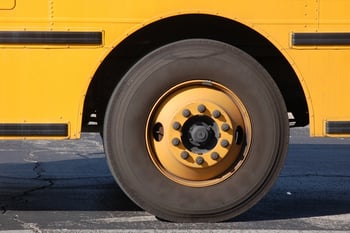Could Fuel Efficient Tires Be The Solution To The Gas Crisis?
published on June 28, 2022 by Sonia Mastros
school bus management, route optimization, school bus routing software, School Bus Routing, fuel efficiency, fuel efficient tires, school bus costs, school bus driver shortages, inefficient routes, outdated routes, inaccurate routes, route efficiency, state reporting, re-routing, bus shortages
 School districts across North America are employing several transportation management solutions to increase fuel efficiency and cut costs, especially given the recent spike in gas prices. Investing in fuel-efficient tires for their buses is one chosen strategy. The question is, do tires designed for fuel efficiency really work? The short answer is: they do, but they don’t necessarily save districts money.
School districts across North America are employing several transportation management solutions to increase fuel efficiency and cut costs, especially given the recent spike in gas prices. Investing in fuel-efficient tires for their buses is one chosen strategy. The question is, do tires designed for fuel efficiency really work? The short answer is: they do, but they don’t necessarily save districts money.
How Tires Contribute to Fuel Efficiency
Fuel-efficient tires have been around for a long time. However, with increased focus on environmental concerns, they are now more readily available. The technological concept behind these tires is that their low rolling-resistance leads to reduced fuel use. Basically, they minimize the amount of effort a vehicle has to expend into making the tires roll. These tires increase fuel efficiency by a mile or two per gallon, which adds up, when you consider how far most vehicles drive.
Are Fuel-Efficient Tires the Best Choice for Your District?
Tires which are classified as “fuel-efficient” can cut costs, but are not necessarily the best choice for school buses. These specialty tires are designed for long-hauls, rather than the stop and go patterns of a typical bus. While this might save money on a tractor trailer route, it won't necessarily lead to savings for school transportation departments. This is why many districts choose tires based on long-life, rather than their ability to reduce fuel costs.
Another important factor to consider is the geographic location of your district. Rugged terrain, frequent snow or rain and other environmental factors could necessitate the use of "high-grip" tires. Though not as fuel efficient, they are safer for use on slippery or uneven surfaces.
This doesn’t mean that fuel-efficient tires shouldn’t be considered by your district as one of your transportation management solutions. Even if the cost of these tires can sometimes outweigh the funds saved by increased fuel-efficiency, there are additional benefits that might make a case for making the switch.
The same rolling resistance properties responsible for reducing fuel use are also credited for a smoother ride. A less jarring ride reduces safety risks. This can lead to a better rider experience, particularly for students with special needs.
Another argument for fuel-efficient tires is the length of routes in rural districts. Because of their design, longer rides mean greater savings, so for some districts; these specialty tires could be well worth the investment.
Ultimately, the decision to switch to fuel-efficient tires should be weighed against the needs and priorities of an individual school district. They can save money, but there are other tactics which can provide similar results. Strategies such as streamlined routing and utilizing alternative fuel sources can also lead to major cost savings for school districts.
To learn more about ways that your school district can reduce its transportation costs while ensuring the safety of students, click below to contact one of our transportation management solutions experts.
What do you think? Has your district switched to fuel efficient tires? How has this changed the way you transport students? Let us know in the comments below!






